With the UEFA Champions League coming at us thick and fast, there was barely time to breathe before we got into the second round of matches. Liverpool’s first home game of the tournament saw them go up against Danish domestic champions Midtjylland, a team known for their focus on data for all footballing matters at the club. This tactical analysis will look at the tactics both sides used in this game, with Midtjylland having control in the first half, and Liverpool switching their playing style in the second half to score the goals that would end up winning them the match.
Lineups
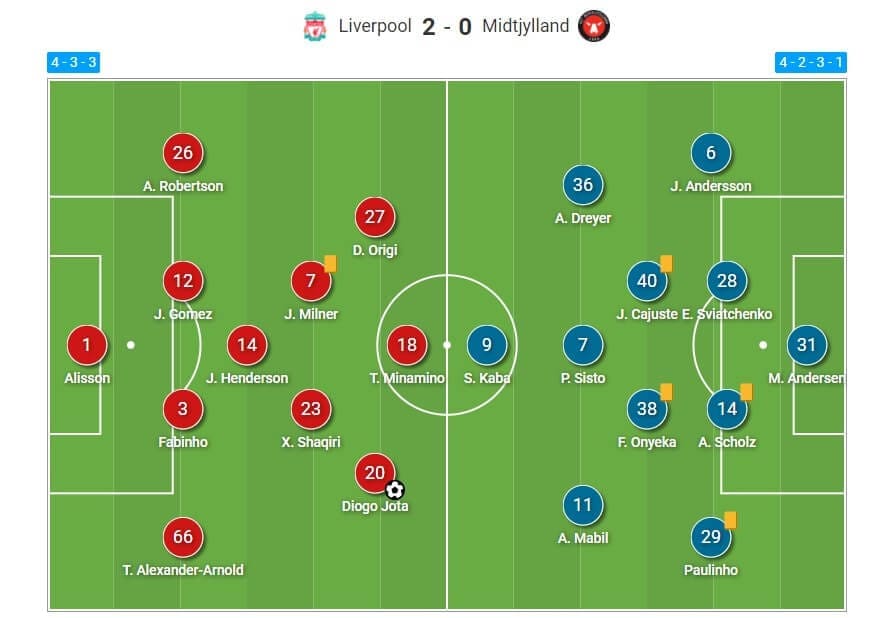
Liverpool started with their familiar 4-3-3 formation, but the lineup was different to how we are used to seeing it. Sadio Mane, Roberto Firmino and Mo Salah were all on the bench, with Divock Origi, Takumi Minamino and Xherdan Shaqiri selected in their place. Shaqiri played in the midfield three, with Diogo Jota moving to the forward line to play alongside Origi and Minamino. Netherlands midfielder Georginio Wijnaldum also dropped to the bench, with James Milner starting in his place. Fabinho was again deployed at centre-back, partnering Joe Gomez, as Liverpool’s defensive issues continued.
Midtjylland, meanwhile, started several familiar names, with former Celtic defender Erik Sviatchenko captaining the side, while Denmark winger Pione Sisto and former Brighton and Hove Albion winger Anders Dreyer were also named in the eleven. Guinea striker Sory Kaba led the line, with the Danish side opting to play with a 4-2-3-1 formation.
Midtjylland’s first half attack
The first question that many were asking about this game was how Midtjylland would look to play at Anfield; sitting back and defending, or attacking and going for it. In reality, they did a bit of both, but with a clever balance. We will first look at their attacking tactics in the first half, before analysing how they stopped Liverpool creating chances.
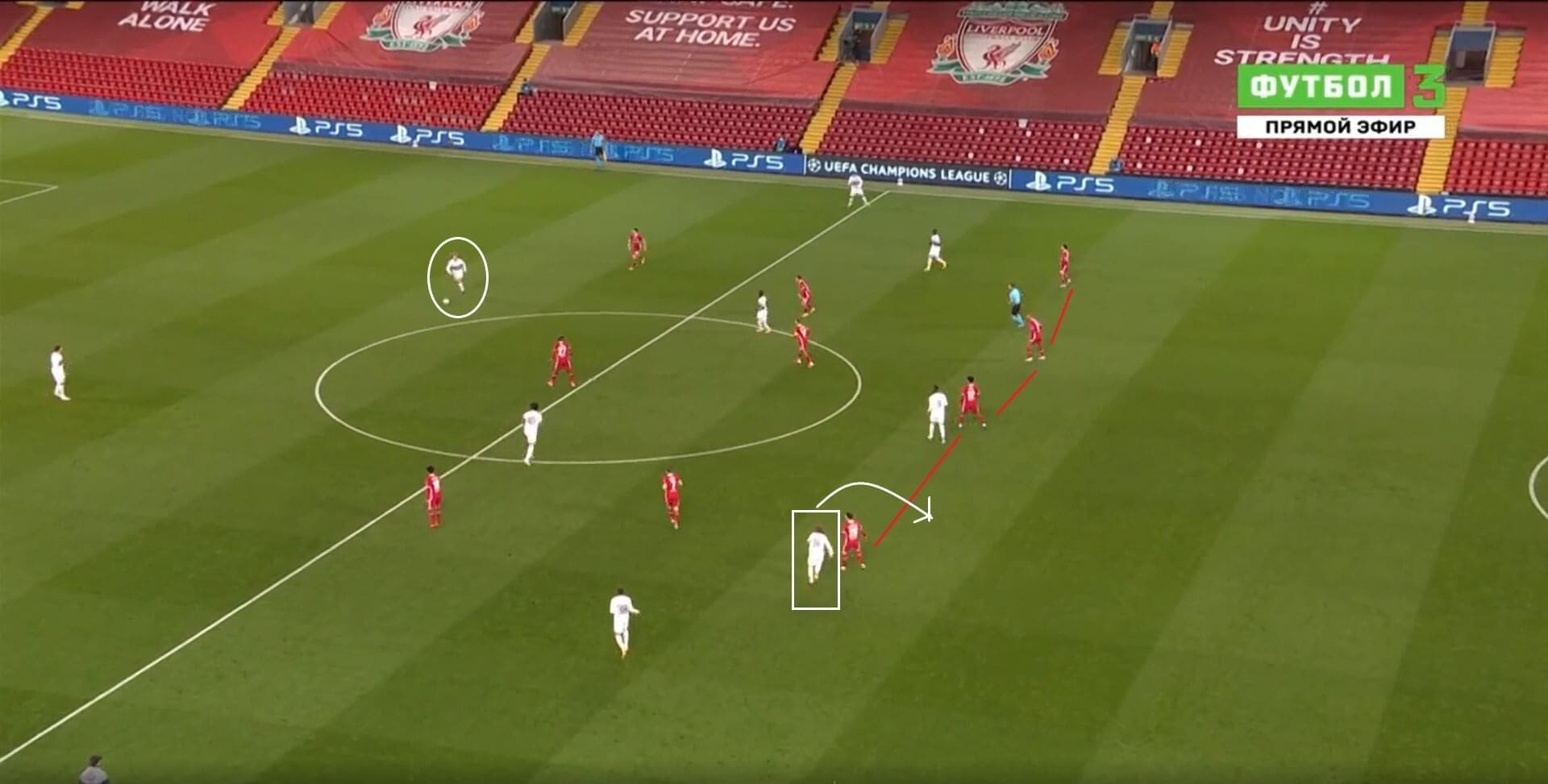
It was clear early on that Midtjylland had done their homework, and had come with a plan on how to get around Liverpool’s well-drilled system. In this image, we can see how they looked to get the ball into the danger areas as early as possible, with the wide attackers, Dreyer and Australia international Awer Mabil, tasked with creating problems around the edges of Liverpool’s defensive line. We can see how the ball is about to be passed into the final third, and Midtjylland have made a run in front of Andrew Robertson, getting past him and offering a passing option behind the Liverpool defence.
This shows how they saw where the spaces were, and knew how to access them in the best possible way. Liverpool’s wide defensive structure leaves these gaps available, but, because Midtjylland set up with a wide attack, they had to spread out in this way to ensure the Danish side didn’t have unopposed control of the wings. This was just one way that Midtjylland looked to create problems for Liverpool.
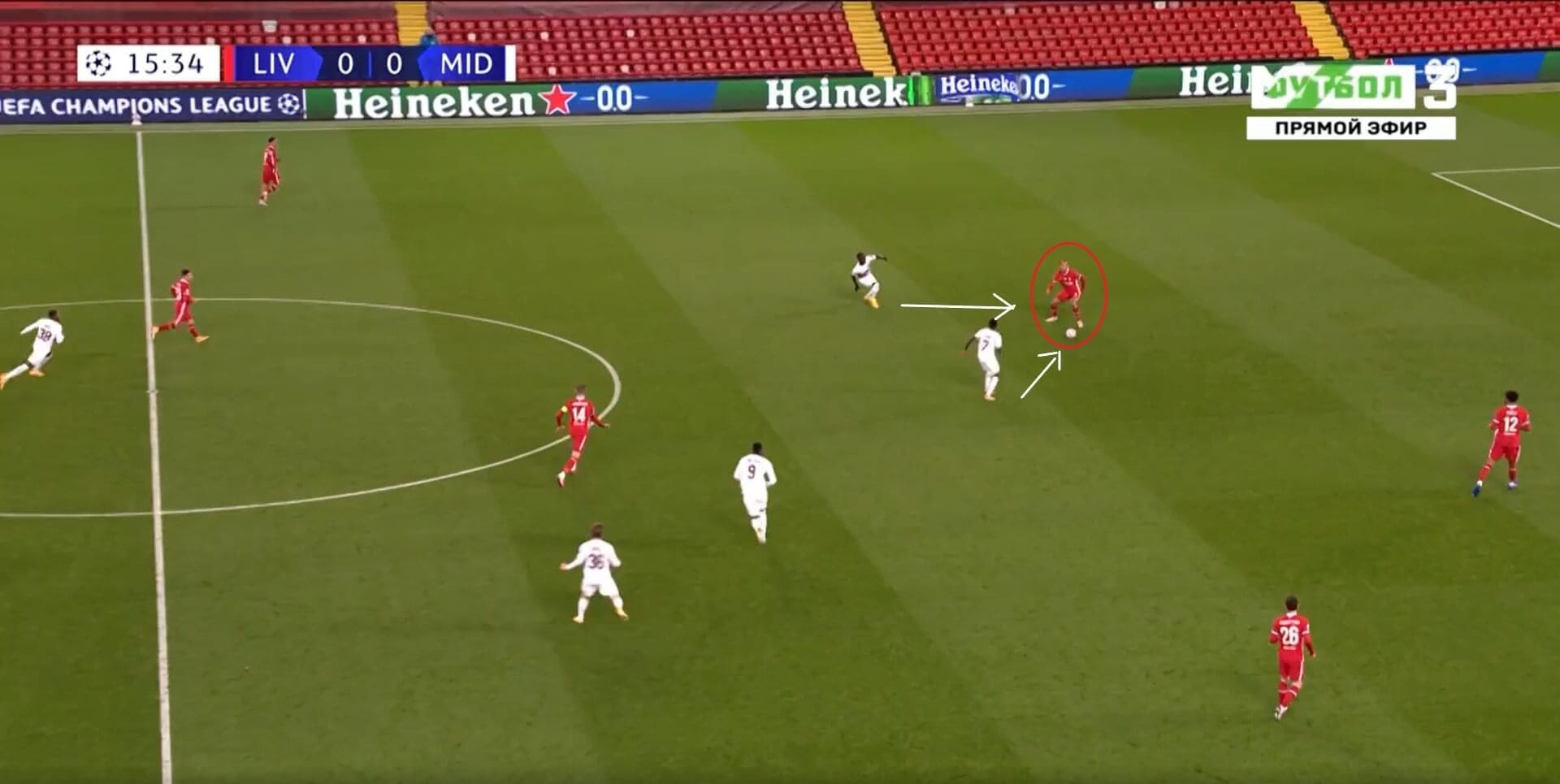
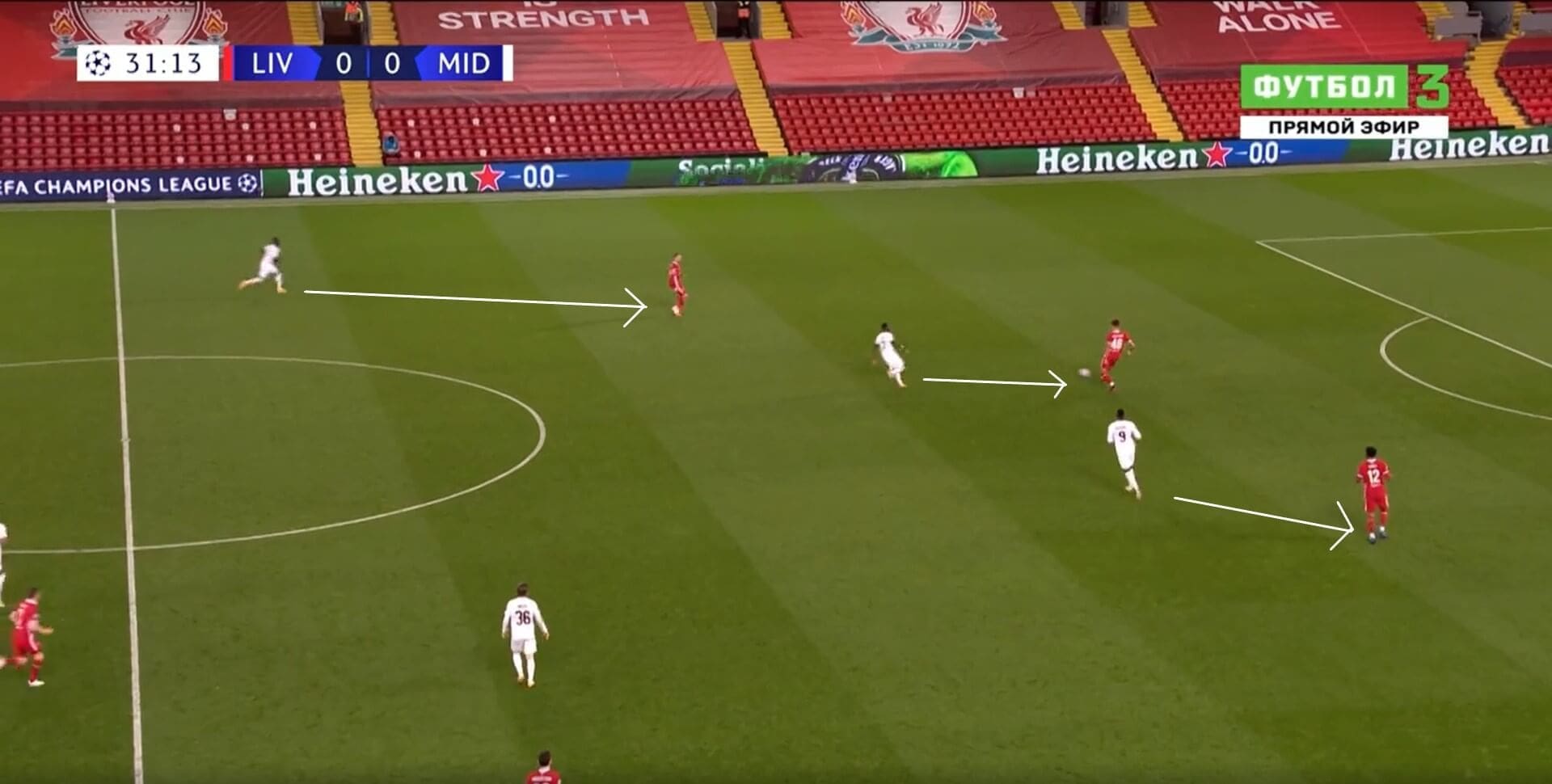
Their main tactics revolved around keeping Liverpool back, stopping them getting the ball into the danger men at the other end of the pitch. They did this by pressing whichever Liverpool player had the ball, as we can see in both of these images.
The first image here shows how Fabinho has received the ball, but he doesn’t have time to look up and find a teammate ahead of him, due to the opposing attackers closing him down. Therefore, his only choices are to play a one-touch pass back to Joe Gomez or Andrew Robertson on the nearside, or to turn and give the ball to Alisson in goal. He can play it forwards, but you can see how this would risk losing the ball. Therefore, we can see how Midtjylland made life difficult for Liverpool at the back with these pressing tactics.
The second image shows another way that the visitors closed Liverpool down. In the first image, two players pressed Fabinho, but now there are three attackers all pressing one Liverpool defender each. They were also clever in the way they did this too, with one of the Midtjylland players moving towards whichever Liverpool player had the ball, and then it would be passed and the next player would go, and so on, giving Liverpool no time on the ball and a massive headache on how to get the ball out of these areas. Therefore, as the ball was passed down the line, no space was ever given to Liverpool, which was important.
The intensity of Midtjylland’s pressing was also meant to force Liverpool into making passing errors, and we can see in the image below how that was the case in the first half.
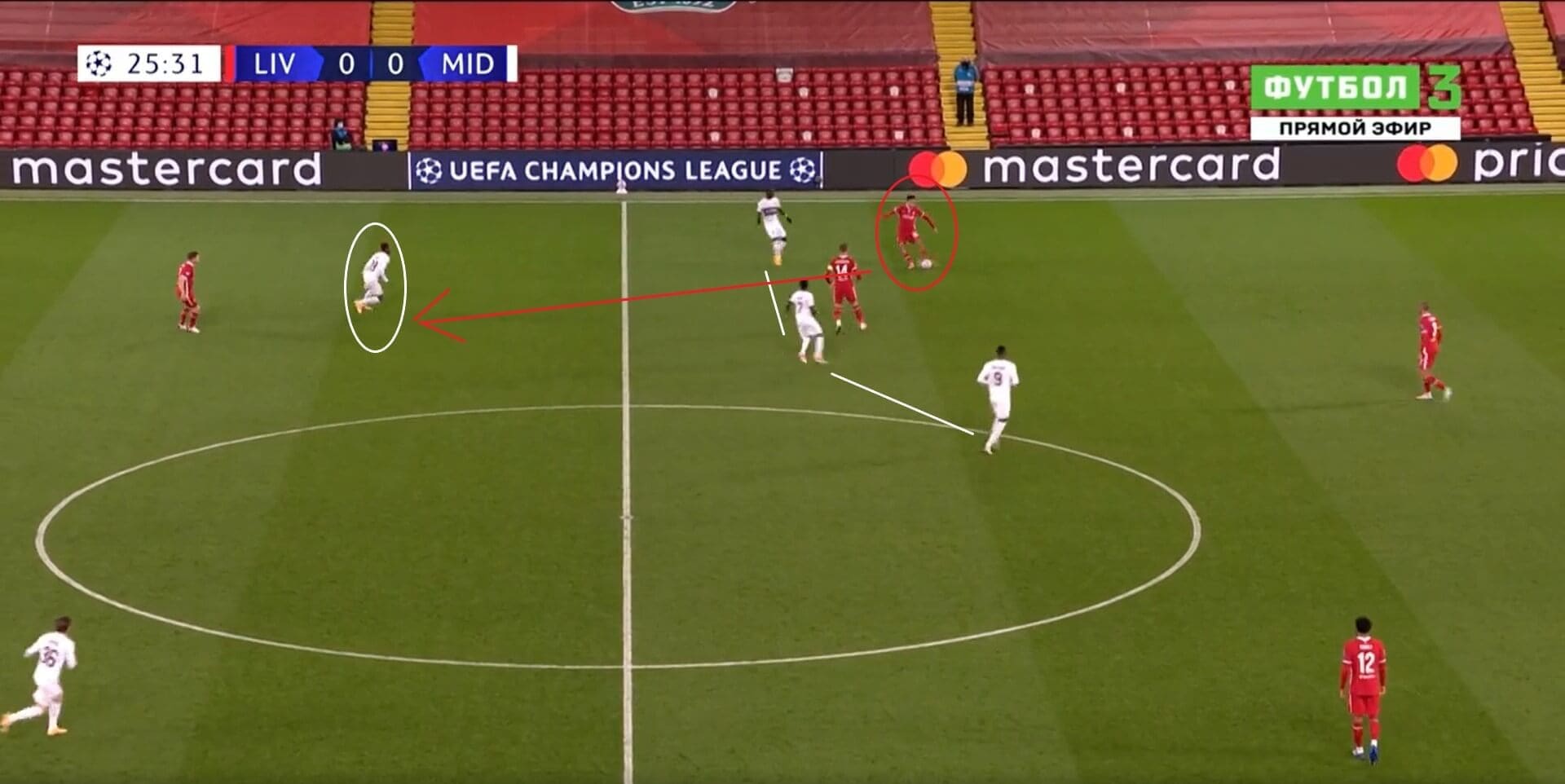
Here, Trent Alexander-Arnold is being closed down by three Midtjylland players, and you can see how this gives him limited space and time to decide where to play the ball. He looks to play the pass through them, but it is then met by a fourth Midtjylland player. Therefore, the press has forced Liverpool to give the ball away, and in a dangerous area.
This was clearly something that Midtjylland had worked on before this game, and it was evidently a success for them.
Midtjylland’s containment tactics
The second part of their first half tactics was in their defence, where they looked to contain Liverpool’s forward line, stopping them from creating chances.
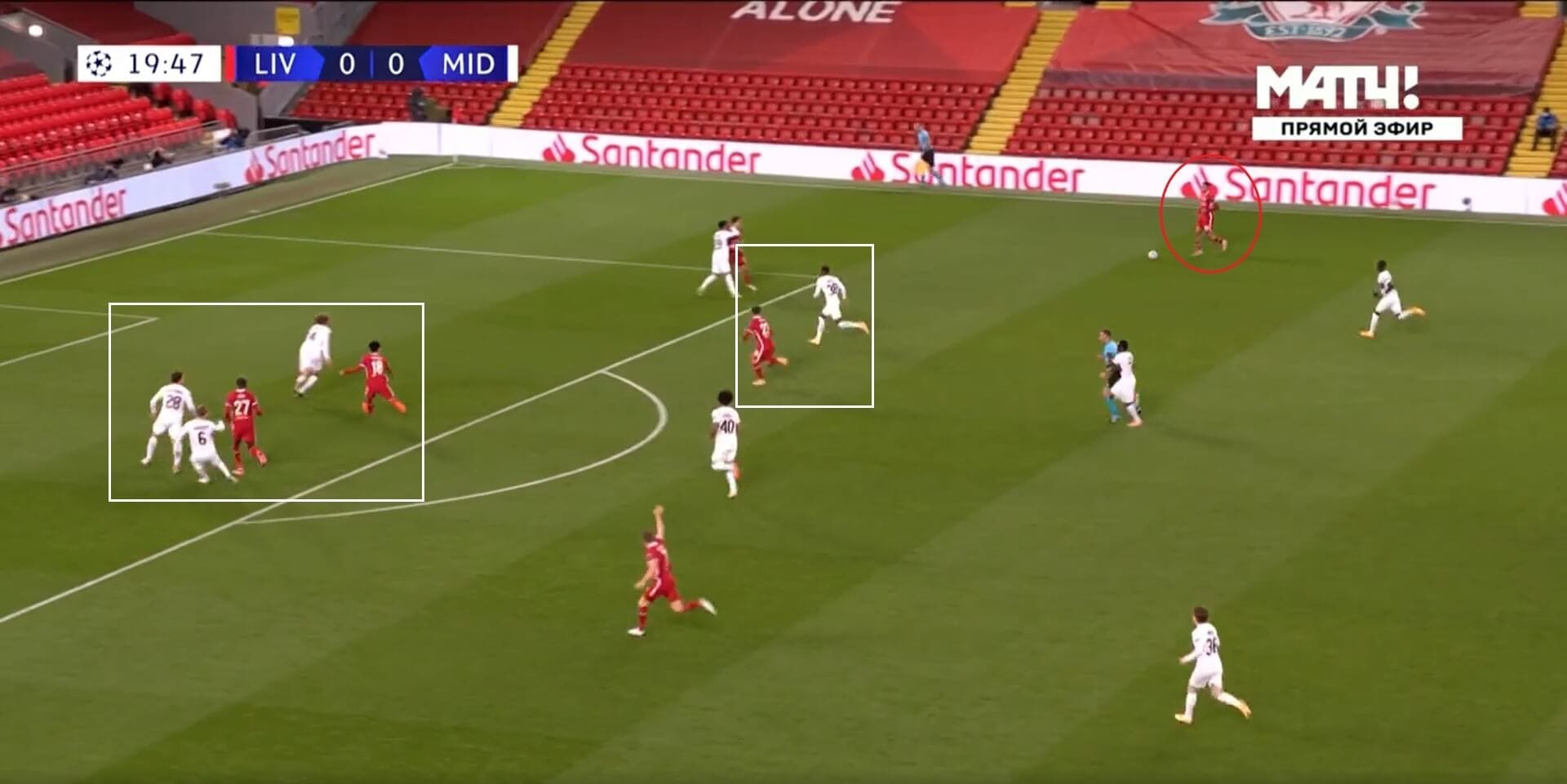
Here, we can see one example of their marking technique when Liverpool had the ball in a dangerous area. We know that Liverpool’s attack relies on the full-backs getting up the pitch and crossing into the box, but it also relies on those full-backs having central target players to get the ball to. Here, Midtjylland have allowed Trent Alexander-Arnold to have the ball, but he can’t cross it in, because all three of the forward players have been marked tightly, as is shown in the white boxes. Therefore, Alexander-Arnold has to pass the ball backwards, giving Midtjylland more time to get back and occupy the open space in front of goal.
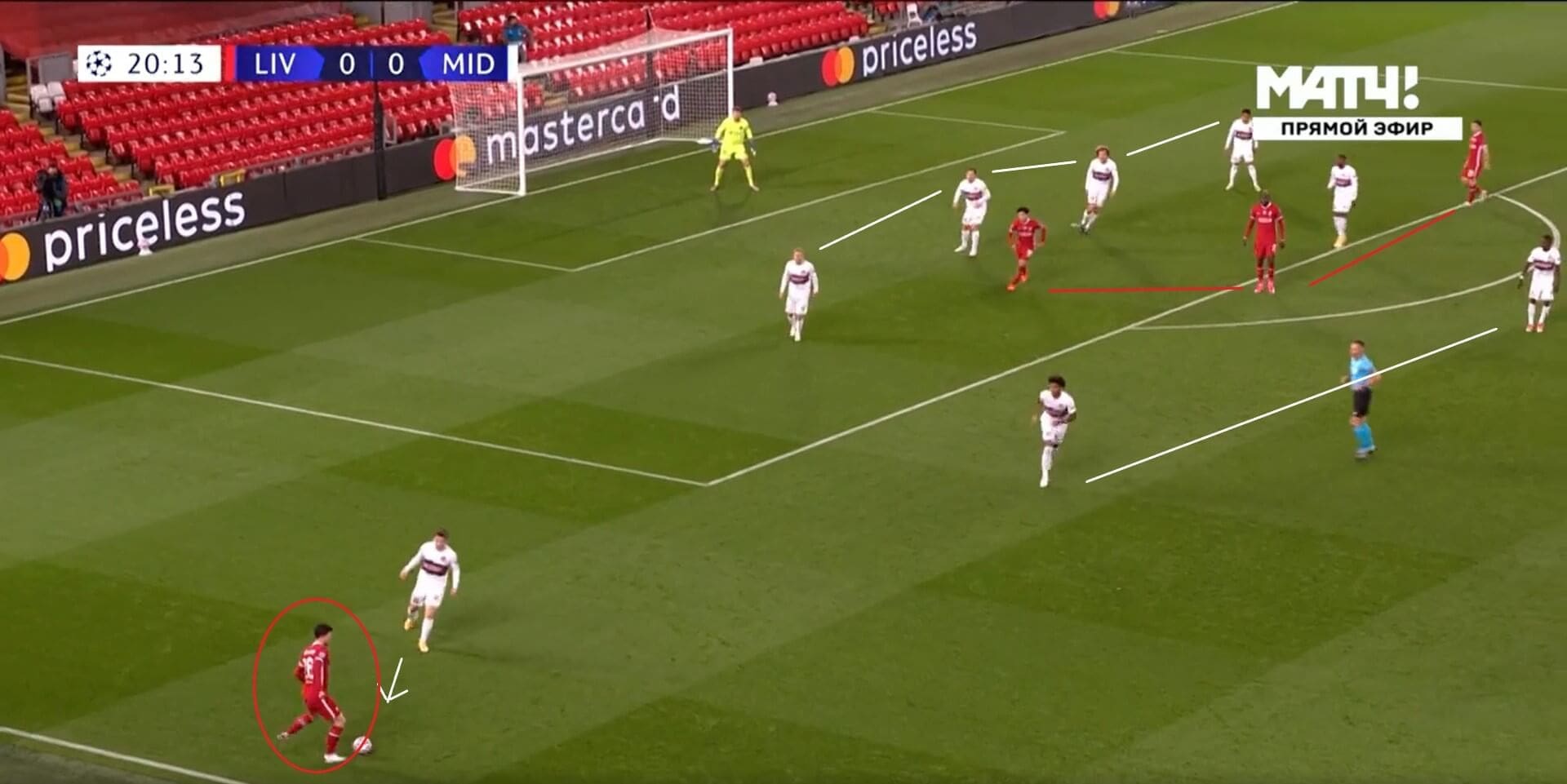
When it wasn’t possible to use man-to-man marking, Midtjylland instead formed two lines and squeezed Liverpool’s attackers between them, as we can see in this image. The defensive and midfield lines here have formed a narrow defensive structure, and all three of Liverpool’s forward line are now in between them, unable to receive the ball. Just for added measure, Andrew Robertson, who is looking to make the cross into the area, is also being closed down by another defender. Due to this, and the central threat being closed off, he now has to play the ball backwards, and this again ends the threat.
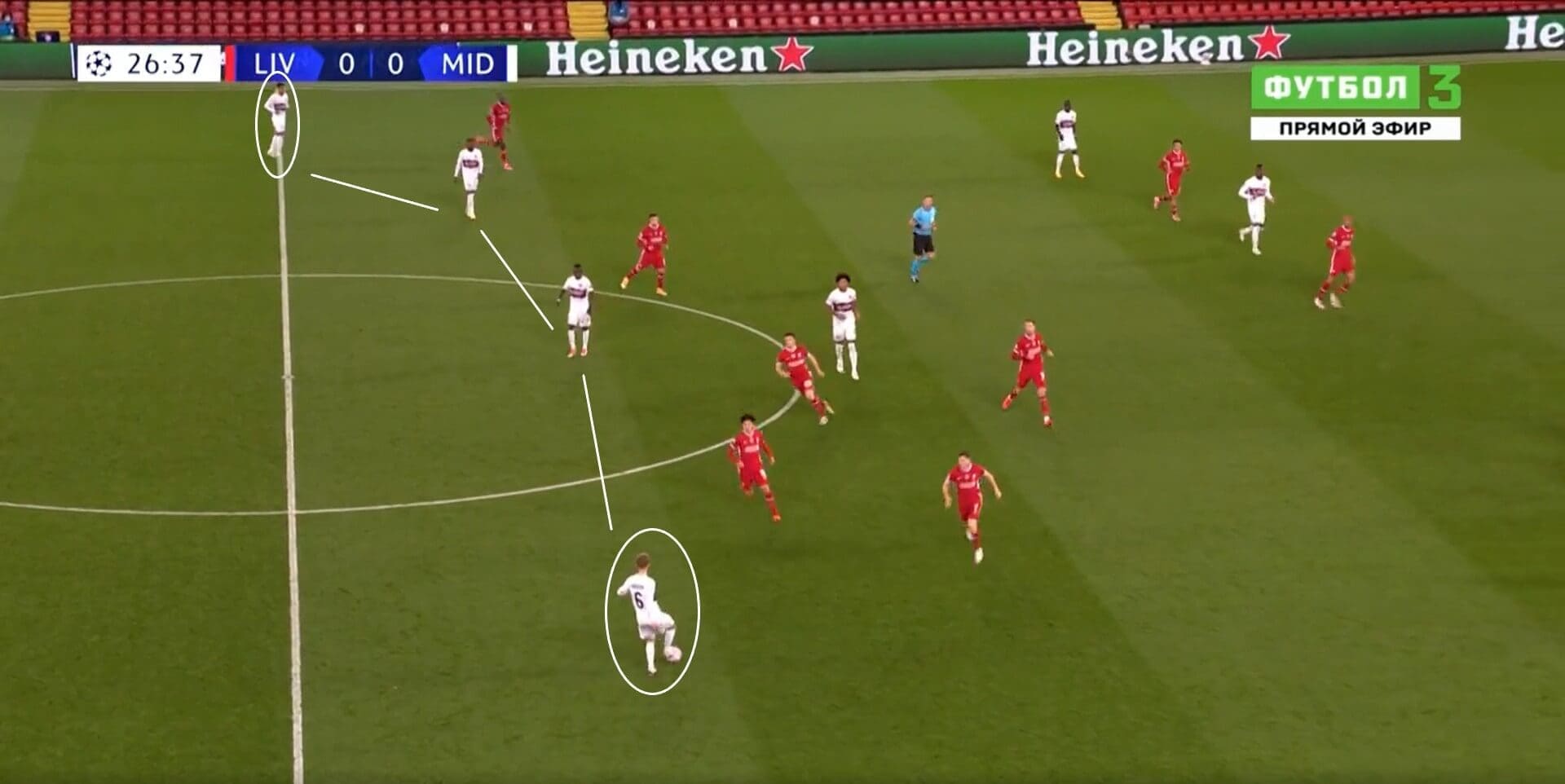
It wasn’t just in their own goal area that Midtjylland looked to contain Liverpool. Here, we can see how they have trapped Liverpool in their own half. This is done by the two full-backs, Joel Andersson and Paulinho, moving up to join the midfield. They are operating here almost as wing-backs, and this gives them a straight line of four on the halfway line. Now, from this position, Andersson, who has the ball, has a number of different passing options he can make, so we can see how this tactic created opportunities for Midtjylland, as well as stopping Liverpool attacking forwards.
So far, we have seen how Midtjylland came to Anfield with a plan for how they were going to stop Liverpool from creating chances, not by sitting back behind the ball, but by using clever tactics that meant Liverpool couldn’t play the way they normally like to, and the fact that they hadn’t had any shots at goal, or created any chances, in the first 30 minutes or so of the game highlights how well these tactics worked for the away side.
Liverpool’s second half tactical changes
It goes without saying that Liverpool needed to change something in the second half, and that is what we will now come on to.
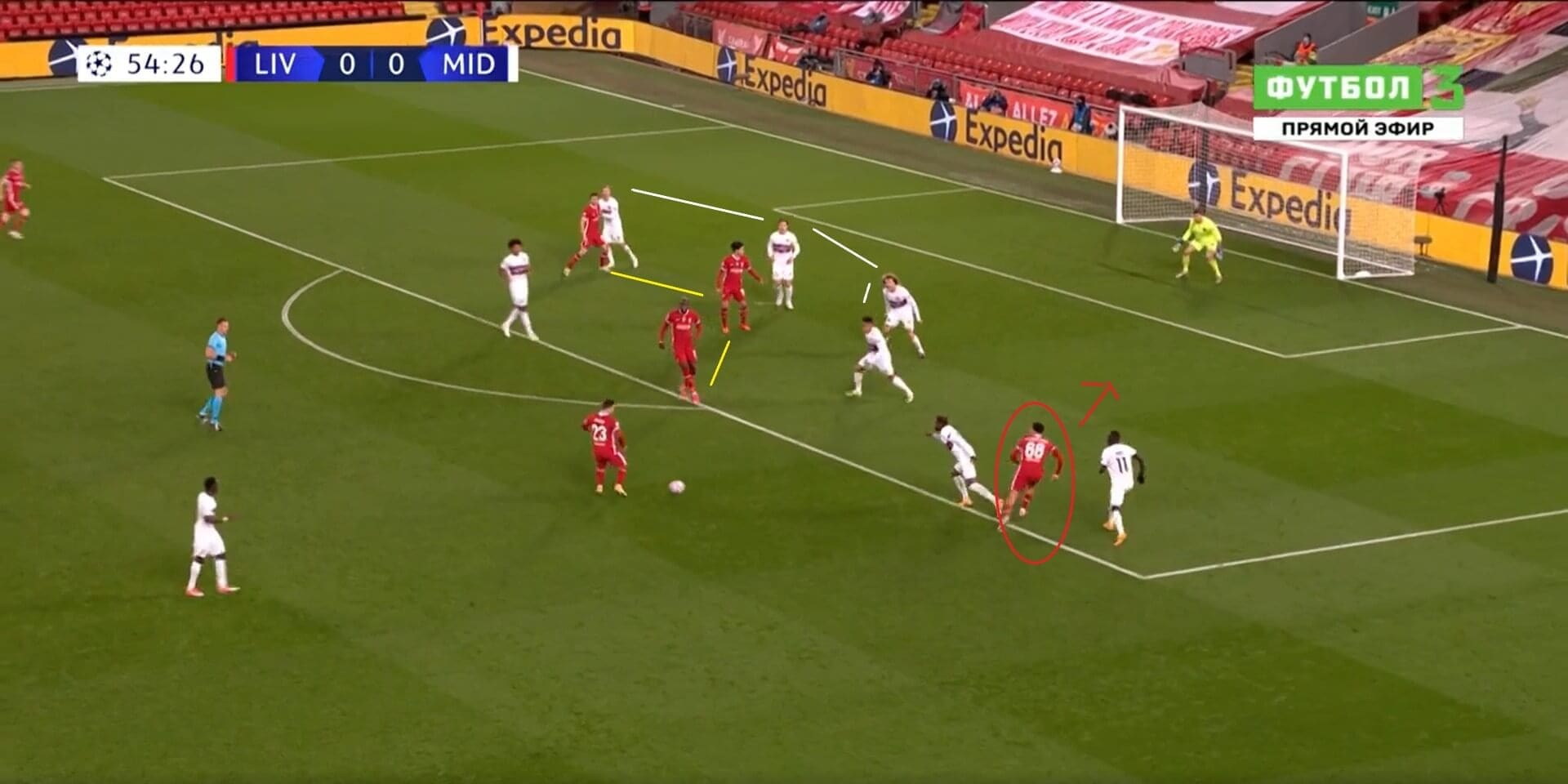
The most noticeable thing about Liverpool’s three forward players, Diogo Jota, Takumi Minamino and Divock Origi, was that they played very narrowly, making it easy for Midtjylland to close them down, as was shown in the previous section. The fact that they were often in very close proximity to each other meant that, should the ball come to one of them, there wouldn’t be a passing option available in space elsewhere in the box.
However, this image shows how Liverpool changed this in the second half. Alexander-Arnold and Robertson both came inside much more in the second half, and looked to get into the box to balance the attack out. Here, Alexander-Arnold has played the ball to Xherdan Shaqiri, before running through the defence, where it is not as well-organised, and offering the possibility of a one-two with the Switzerland winger. This image actually leads to the opening goal of the game, with Alexander-Arnold receiving the ball and passing it across goal for Diogo Jota to tap in, which demonstrates how Liverpool’s tight attacking structure in the first half was one of the reasons they struggled to create opportunities.
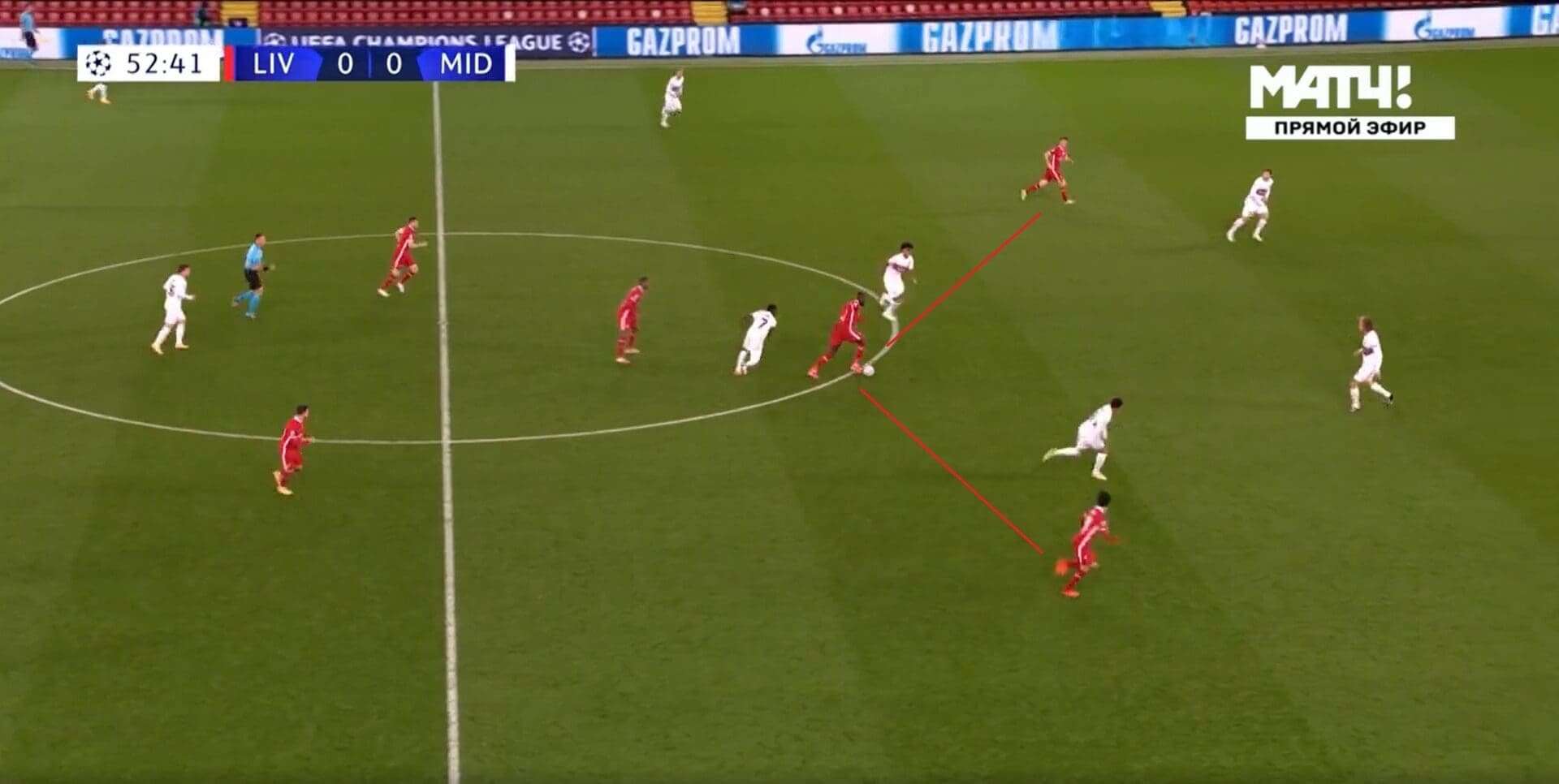
This image shows another example of the narrow attacking structure, which is a downside of the 4-3-3 formation. Divock Origi has the ball, with Diogo Jota and Takumi Minamino playing off him, looking to get the ball behind the Midtjylland defence. However, they needed to be wider when doing this, as it would have stretched the defenders away from each other, creating gaps in between them.
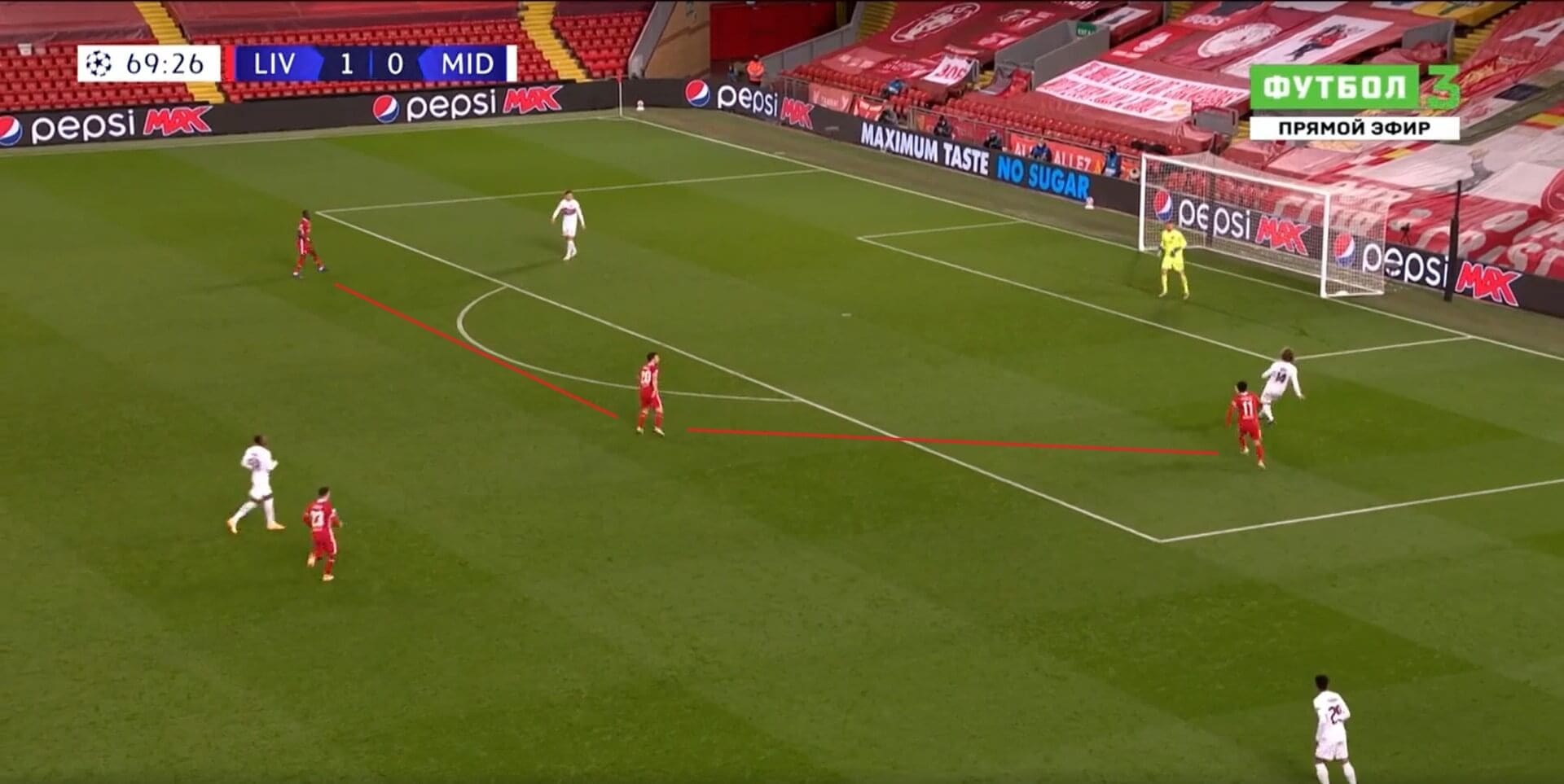
Once Mo Salah and Sadio Mane had come on for Minamino and Origi, Liverpool had a more stretched out attacking line, as we can see in this image. Now, we can see how the Midtjylland defenders are finding it harder to stop them attacking into the box, with Salah in particular chasing down every ball on his side of the pitch. The two centre-backs have also become isolated, and, just like with Liverpool in the first half, they don’t have many options for where to pass the ball too.
Therefore, we can see how Liverpool changed their attacking tactics in the second half, bringing the full-backs into the box as a fourth attacker, which created space and passing opportunities to get the ball too. It also stretched the forward line out, which made it harder for Midtjylland to surround them and close them down.
Xherdan Shaqiri’s altered role
The other notable change in the second half came from a half-time substitution. Captain Jordan Henderson was withdrawn at the break, with Georginio Wijnaldum brought on in his place. Wijnaldum has a little more defensive quality in his game, and is more likely to sit back and help protect the defence than make marauding runs forwards. This then gave Xherdan Shaqiri more freedom to get forwards and help the attack, which then helped Liverpool to get more balls into the forward players.
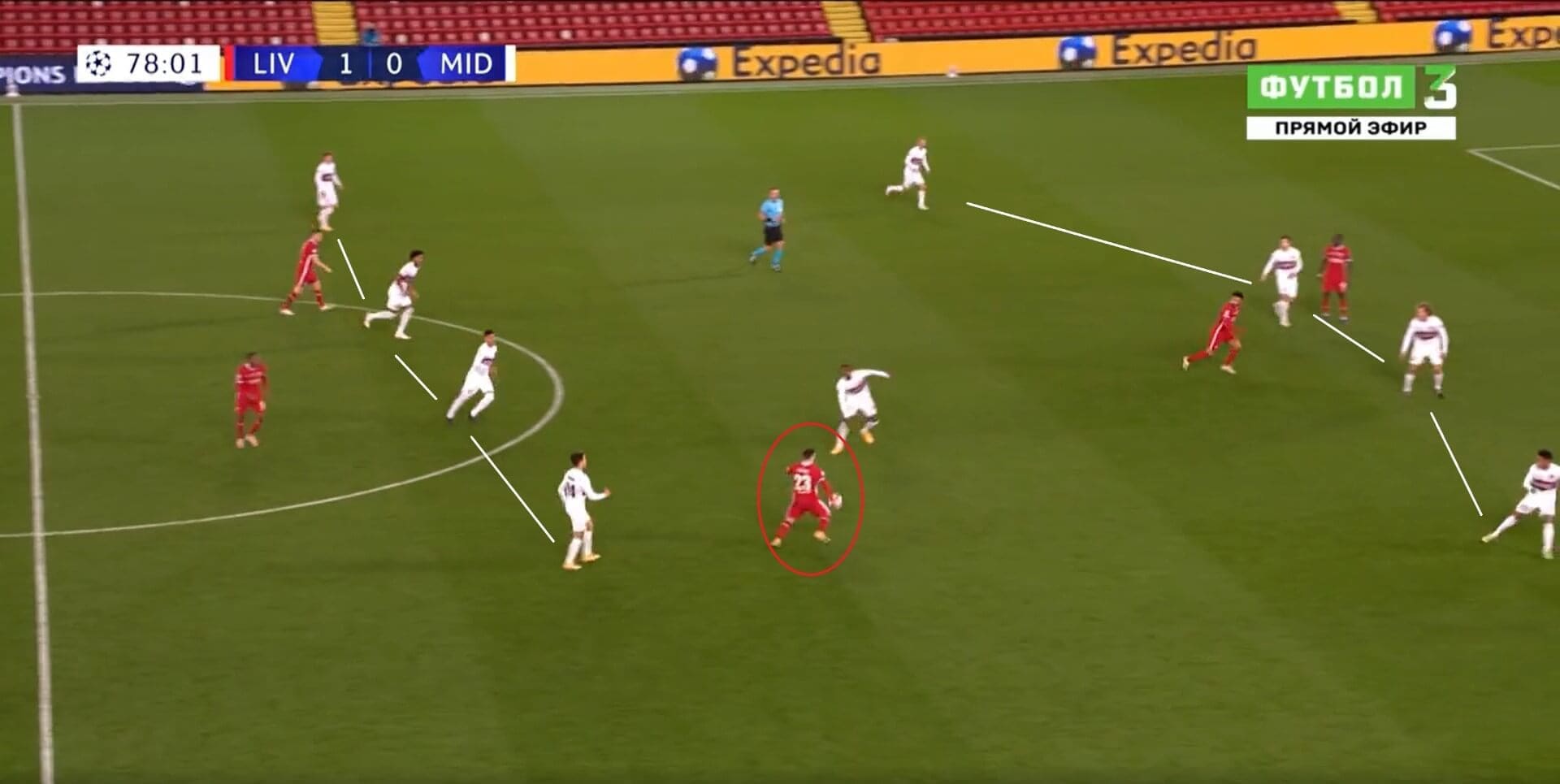
We can see from this image how Shaqiri took up a role between the Midtjylland midfield and defence, with those two marked by the white lines. Shaqiri acted as the link between Liverpool’s midfield and attack, and we can see here how he has received the ball, looking to get it into the attackers. This shows the impact he has on his team when in these areas, and the creativity he offers his team in the final third. You can see how the attackers know to get behind the Midtjylland defence, because that is where Shaqiri will look to get the ball if he can make the pass.
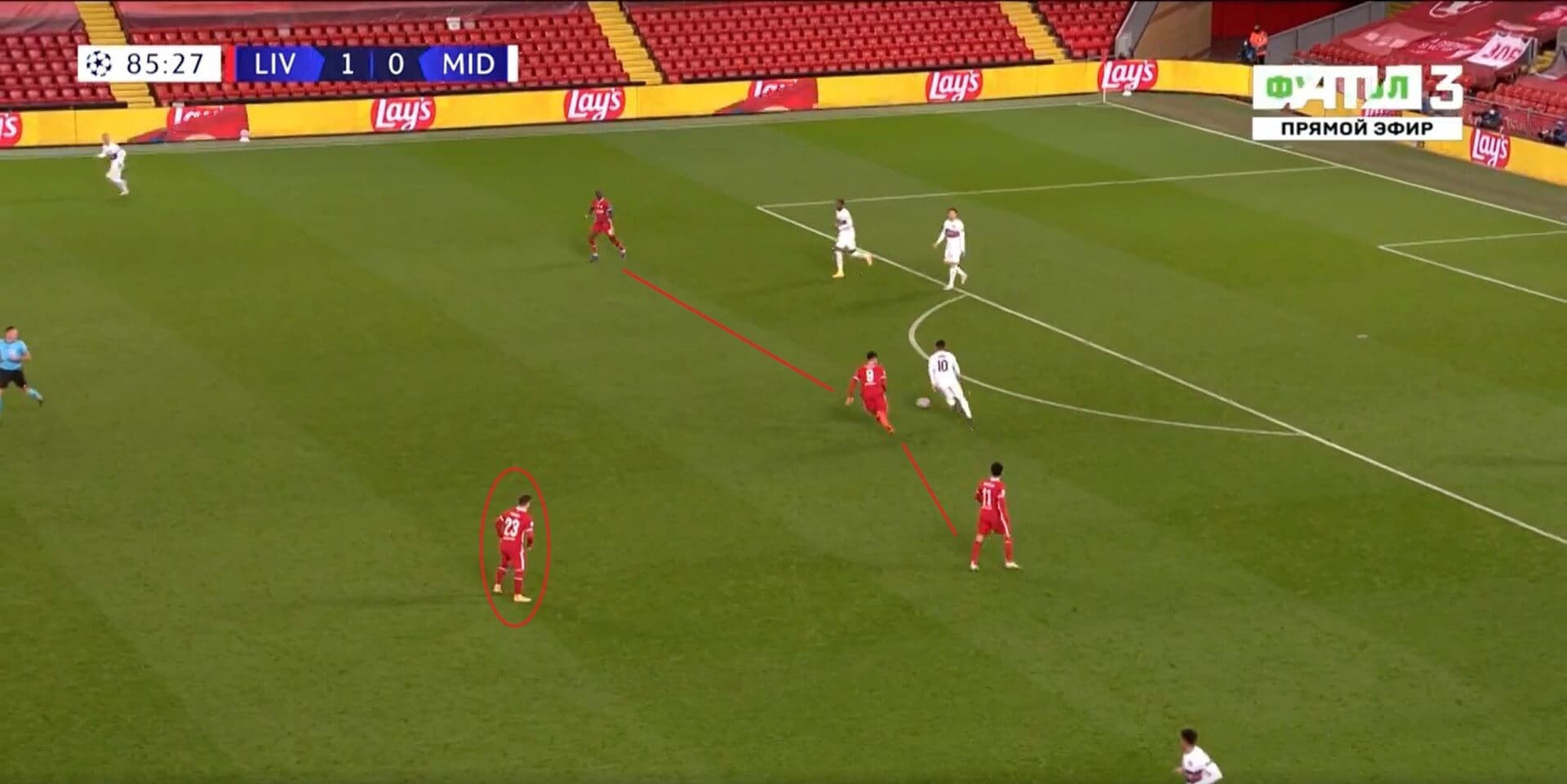
His role as the creative player behind the main forward line is further demonstrated in this image, with Roberto Firmino having come on by now to join Salah and Mane in the usual forward line, replacing Diogo Jota. All three attackers are now chasing the ball down, and Shaqiri is behind them, ready to pick up the ball if it comes his way. Liverpool lacked this type of player in the first half, relying on their full-backs to create chances. However, as we have seen, this was something Midtjylland picked up on and prevented in the first half. Therefore, Liverpool needed to find another way of getting support to the forward line; allowing Shaqiri to get up the pitch to play in the space behind them was one way that they did this.
Conclusion
In conclusion, this game was a tactical battle for both sides, as this analysis has shown. We have seen how Midtjylland started the game well, playing with a clear game plan, and succeeded in keeping Liverpool at bay for the first half. However, Liverpool rethought their tactics at half time, and were able to take control in the second half, scoring the goals that ensured they made it two wins from two in this season’s Champions League. The group stage games keep coming, with both sides back in European action next week. Midtjylland will look to get off the mark in this year’s competition when they host Ajax, who have only gained one point from their first two games this season, whilst Liverpool travel to Bergamo for a tricky tie against Atalanta.





Comments